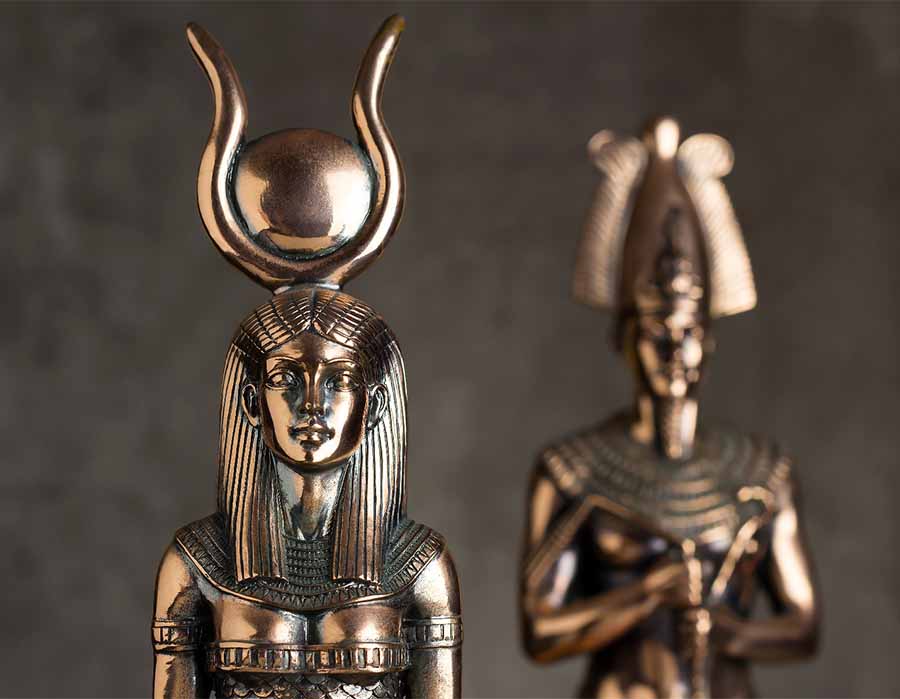
The Origin And Purpose Of Egyptian Civilization According To Ancient Hermetic Texts
The Korê Kosmou or Pupil of the Eye of the World is a Hermetic text dating to the third century AD. The Greek text was preserved from antiquity by Johannes Stobaeus of Macedonia as part of his Anthology, hence its abbreviated reference as SH23 (Stobaean Hermetica 23). While most Hermetic writings take the form of fictional dialogues between Hermes Trismegistus and his students, the Korê Kosmou is one of several texts (including SH23-27 and the alchemical Letter of Isis the Prophetess) in which the knowledge is transmitted from Isis to her son Horus. The Korê Kosmou is the product of several older sources weaved together into a single text, resulting in a narrative which serves as a virtual compendium of Hermetic cosmology and philosophy. The narrative of Isis begins with the origin of the Hermetic tradition at the dawn of creation, continues with the creation of human souls, and concludes (at least in its present form) with a mythic account of the origin of civilization.
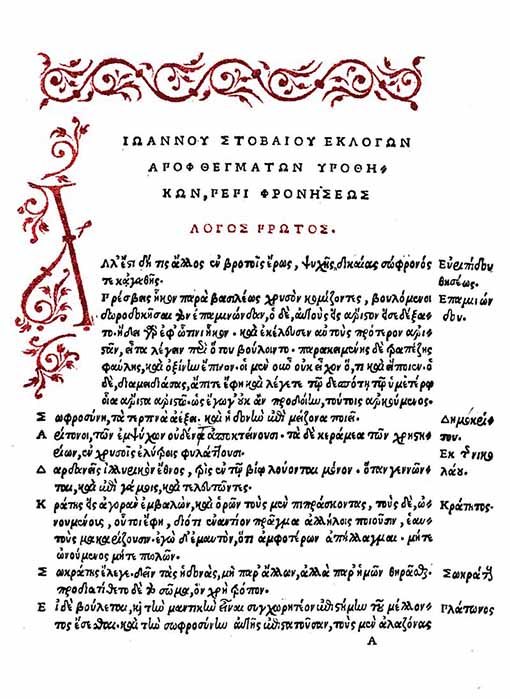
Page one of the Anthology /Florilegium of Stobaeus, from the 1536 edition by Vettore Trincavelli (Public Domain)
The Dawn of Creation
In the Hermetic creation epics, the stars and the seven classical planets are created by a Demiurgic God who sets them on their endless, cyclical courses in order to perpetuate the change of all things in the terrestrial world below. The celestials—which are made of an especially pure form of matter and so never dissolve away themselves—are literally connected to all terrestrial objects and organisms by unseen forces or energies. In this scheme, the movement of that which is above continually affects that which is below, ordering the continual emergence and eventual dissolution of all material bodies made up of the four classical elements. The celestial cycles literally are time, and the ceaseless change perpetuated by time is called becoming (Corpus Hermeticum /CH 11). The purpose of this endless time-becoming is to forever continue the instantiation of eternal ideas and souls from the mind of the Demiurgic Creator—who exists in the Intelligible realm outside of cosmos and time—in the lower material world. The material tents or coverings of all things, including the bodies of human beings, emerge from and return to the matrix of materiality so that new forms may find expression.

First Latin edition of the Corpus Hermeticum (CH), translated by Marsilio Ficino, 1471 AD (Public Domain)
Isis begins her narrative with reference to this cosmic principle: “Since, Horus my child, the many-wreathed heaven lies over every being below and is in no region deprived of the things which the whole world now contains, there was every need that all underlying nature be ordered and brought to fulfillment by the beings above” (SH 23:2). Isis relates that in the beginning, the terrestrial world was “seized with panic” because of the eternal nature and power of the celestials, since the cosmic order was not yet understood as “the beauty of heaven manifesting God” (SH 23:3).
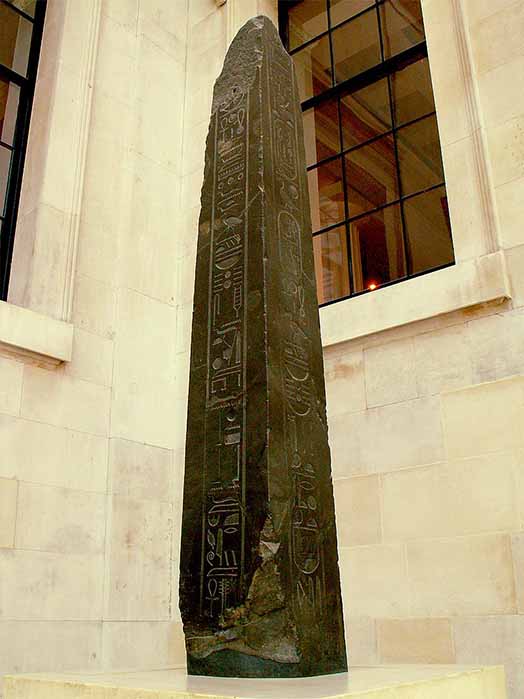
Black siltstone obelisk of King Nectanebo II. According to the vertical inscriptions he set up this obelisk at the doorway of the sanctuary of Thoth, the Thrice-Great, Lord of Hermopolis. British Museum, London (Public Domain)
In order to end this ignorance and fear, the Demiurgic Creator decided to reveal himself by inspiring the primordial gods to seek out his nature and design (SH 23:4). This could only be accomplished by “all-knowing Hermes”, who possessed “a soul corresponding to the heavenly mysteries” (SH 23:5). Hermes then imparted his knowledge to his son Tat and Imhotep-Asclepius, as well as all those throughout time “who, when the queen of all things Providence wished it so” would one day “discover the reliable truth of the heavenly contemplation” (SH 23:6). Hermes also inscribed his revelations on stelae that he hid away “so that every future generation born into the world might seek it” (SH 23:5). These tablets were placed “near the hidden objects of Osiris” (SH 23:7) This allusion to Egyptian temples aligns with the numerous tales of tablets discovered in temple walls, columns, and underground chambers in Greco-Egyptian and latter Arabic Hermetic texts. Having laid the foundations for the knowledge of the cosmic order to be known throughout time, Hermes ascended to the heavens, apparently to the sphere of the planet Mercury (SH 23:8).
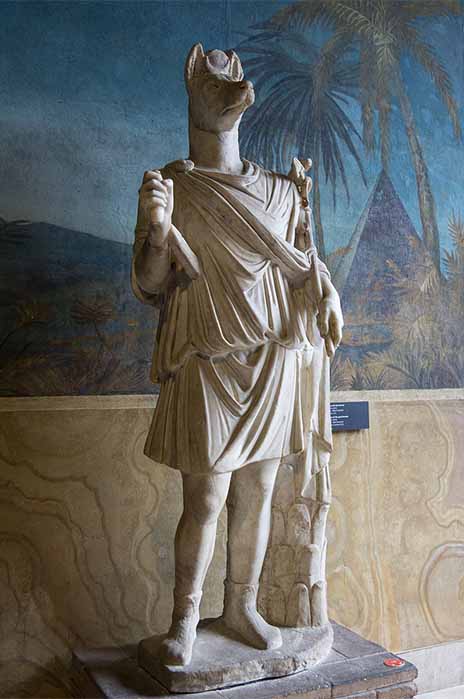
Hermanubis, a Graeco-Egyptian syncretism of Hermes from Greek mythology and Anubis from Egyptian mythology. (1st–2nd century AD) Vatican Museums (Colin/CC BY-SA 3.0)
Creating Human Souls and Animals
After a time, the Demiurgic Creator decides to create human souls from a mixture of his own essence with air and fire, bound together with secret formulae (SH 23:14). Sixty grades of eternal souls are produced, all of which are assigned “districts and chambers in the heights of nature above” in order to “revolve the cosmic axis in due order and efficiency to their father’s delight” (SH 23:16). The cosmic axis—or axis mundi—is the pillar or pole that runs through the center of the entire universe, around which the stars and constellations revolve. The primal form of humankind thus participated in the cosmic process by which terrestrial nature is shaped by the celestials. Specifically, Isis recounts that the Creator made a soul substance of the denser elements of water and earth with which he fabricated the human and animal signs of the zodiac, and then gave the rest of the mixture to the primal souls, instructing them to use it to facilitate the rise of animal life on the earth (SH 23:18-23).
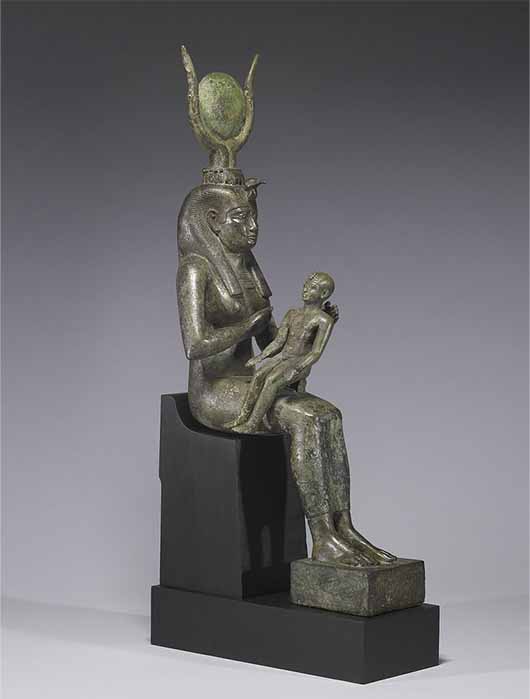
Isis nursing Horus, a sculpture from the seventh century BC (Public Domain)
Isis relates that the primal souls were eventually overcome by “overly inquisitive daring” and abandoned their divinely assigned homes in the heavens to engage in “acts beyond what was commanded, quitting their ranks and stations so that no one stayed put in one place any longer” (SH 23:24). The Creator responds to this cosmic disorder by imprisoning the human souls in mortal material bodies in the terrestrial realm and imbuing them with influences of the seven planets (SH 23:25-30). Some souls rebel against this decree, hissing like asps, while others passionately lament their status as exiles from their celestial homes (SH 23:33-37). The Creator responds to these lamentations by promising that mortal man will have the capacity to rediscover his true origin and purpose, and guarantees that pious souls will return to their abodes in the heavenlies (SH 23:38).
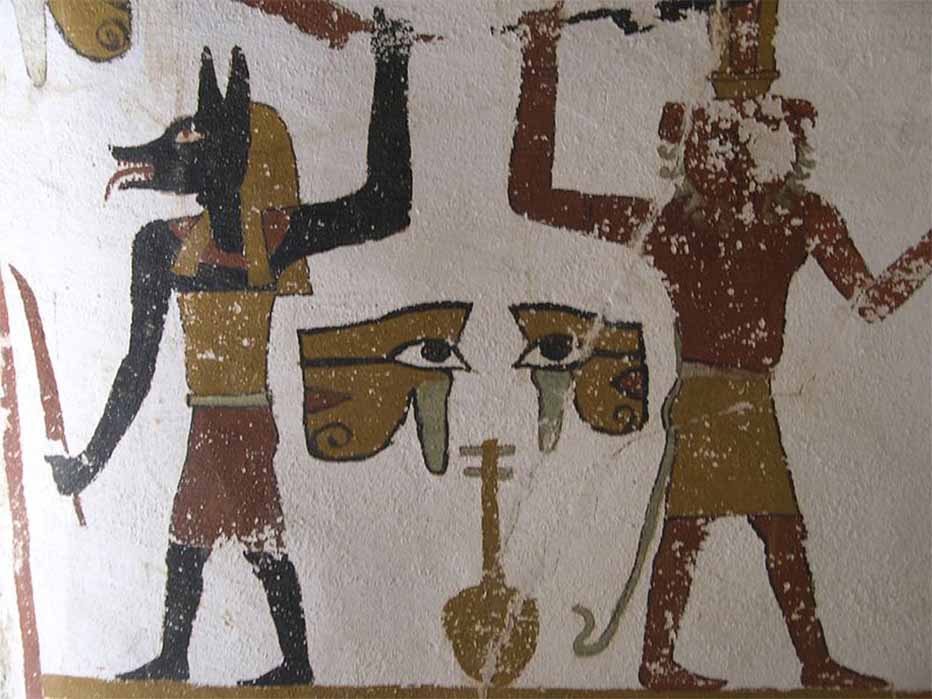
Jackal and lion-headed cavern deities that feed on the souls of the wicked, from the Tomb of Sadosiris (El Muzawaka, Dakhla Oasis) (CC BY-SA 2.0)
Rebellion and Warfare
Despite this divine promise, Isis recounts that incarnate man rebelled against the cosmic order. Perhaps lead by those rebellious souls who “hissed like asps”, human beings attempted to assail the celestials and forcefully reclaim their original place in the heavens (SH 23:53). This was a movement by the powerful, who used “the weaker people who remained as tools”, conspiring to make them “attack, oppose, and battle one another” (SH 23:53). It is noteworthy that the Korê Kosmou here equates power exploitation and organized warfare—the very hallmarks of the modern western world—with the barbarism and chaos that existed prior to civilization as enacted by souls disobedient to God. According to Isis, the world fell into sacralized subjugation and mass murder: “Power mastered weakness. The strong burned and butchered the powerless. They butchered the living all around temples, and threw their dead bodies into the inner shrines” (SH 23:53).
- Hermetic Individuation: The Discovery of the Self in the Teachings of Hermes Trismegistu
- Hermetic Individuation: The Way Of Hermes and The Rite of Rebirth
- The sacred symbol of the Djed pillar
The violations of early man are so extreme that the four elements themselves cry out to the Creator for intervention (SH 23:55-61). Fire askes to be liberated from being used to burn human sacrifices, and air askes to be free of the smoke and ashes of the burned bodies. Water askes to be free of the hands of murderers and dead bodies, while earth—perhaps the most egregiously violated element—requests freedom from the machinations of the “irrational and godless chorus of inhuman creatures” existing within her (SH 23:59). Earth declares that humans acting “lawlessly with respect to everything” have filled her with corpses and drilled into her “with every wicked device”, rendering her “entirely drenched and corrupted with the pus of corpses” (SH 23:60).
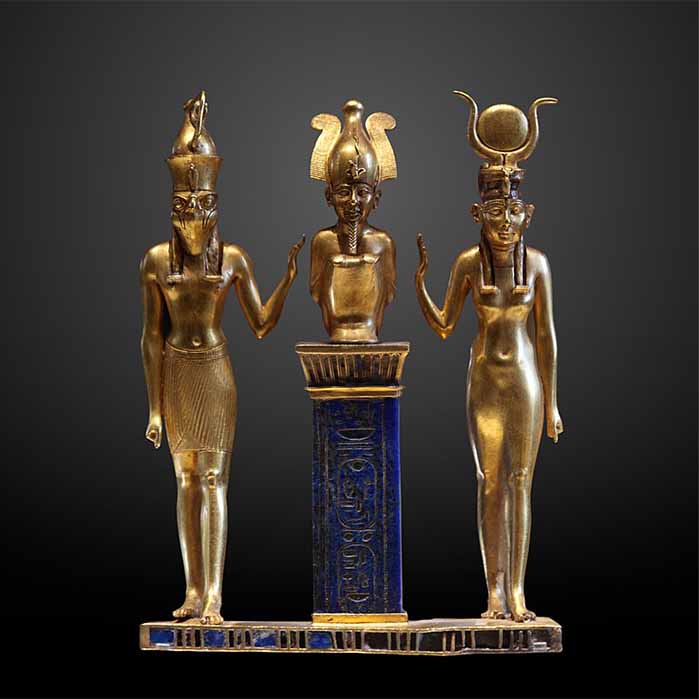
Osiris is depicted on a lapis lazuli pillar in the center, flanked by Horus on the left and Isis on the right. (Twenty-second Dynasty) (Rama/CC BY-SA 3.0)
The Saviors: Isis and Osiris
The Creator responds to the plea of the elements by sending Isis and Osiris to serve “as helpers in a world in need of all things” (SH 23:64). Isis tells Horus that she and Osiris learned the teachings of Hermes hidden away since primordial times, and used this knowledge to civilize mankind (SH 23:65-68). Establishing legal codes, Isis and Osiris put an end to the mass murder and human sacrifices, and consecrated new precincts for pure religious sacrifices (SH 23:65). They founded religious institutions, including the practice of mummifying the dead and the office of the priest-prophet, whose role was to understand the nature of reality and to use philosophy to nourish the soul while using medicine to heal the body (SH 23:67-68).
Isis and Osiris also taught man how to cultivate reliable food sources, and established systems of mutual protection through the institution of the first legal courts for the execution of justice. A Hermetic text housed in the Bodleian Library at Oxford condemns justice systems based on mere opinions, which “have abandoned the true Justice, and the eternal soul joined with a body”, through which people “accuse each other and are accused, practicing mutual hatred rather than mutual affection, hatred of humanity rather than human kindness, ignorance instead of knowledge” (OH 3:1-2). Such systems are said to rely on ignorance and to “abound with clever tricks” and are condemned, since “heaven is pure of such laws” (OH 3:2-3). By contrast, through the teachings of Hermes Isis and Osiris founded a legal system that “filled all things with good order and justice” and introduced covenants and loyalty among mankind (SH 23:67).
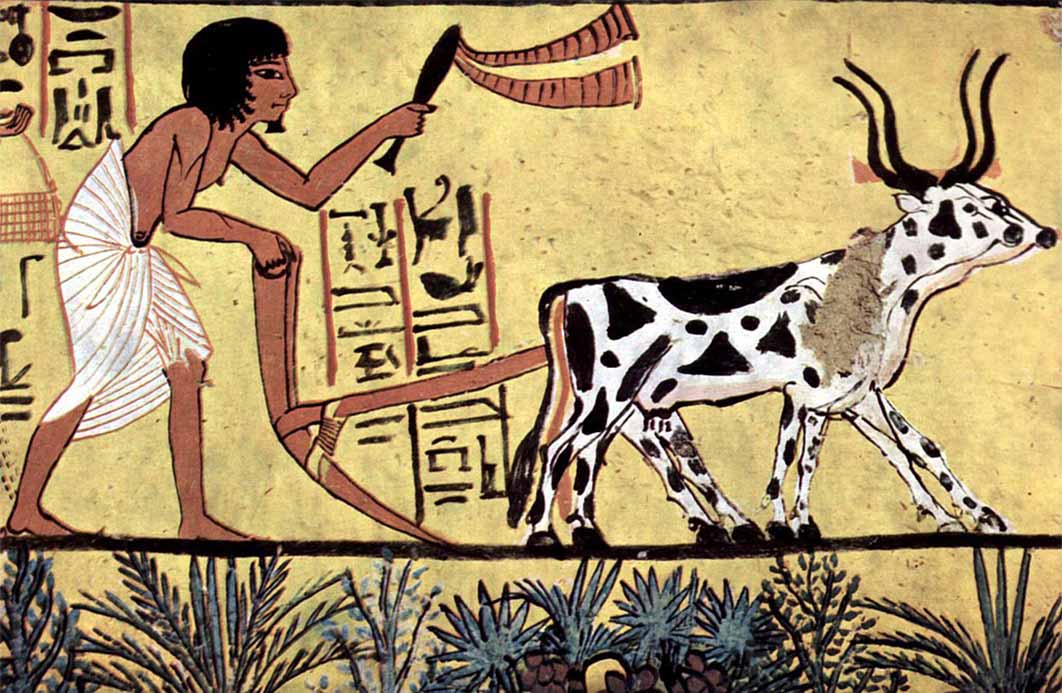
Agriculture in Egypt was a gift of civilization founded by Isis and Osiris. Painting from the burial chamber of Sennedjem (c. 1200 BC) (Public Domain)
Justice and peace, philosophy, spirituality, medicine, and agriculture are therefore all considered gifts of the civilization founded by Isis and Osiris, who so revered the teachings of Hermes that they inscribed them on obelisks and stelae of their own (SH 23:66-67). But how did these teachings inspire such a wide-ranging reformation of the human condition? The answer is found in the narrative: “[Isis and Osiris] alone, after learning from Hermes the secrets of divine legislation, became initiators and legislators of the arts, sciences, and all occupations. They learned from Hermes how lower things were arranged by the Creator to correspond with things above, and they set up on earth the sacred procedures vertically aligned with the mysteries in heaven.”—SH 23:68
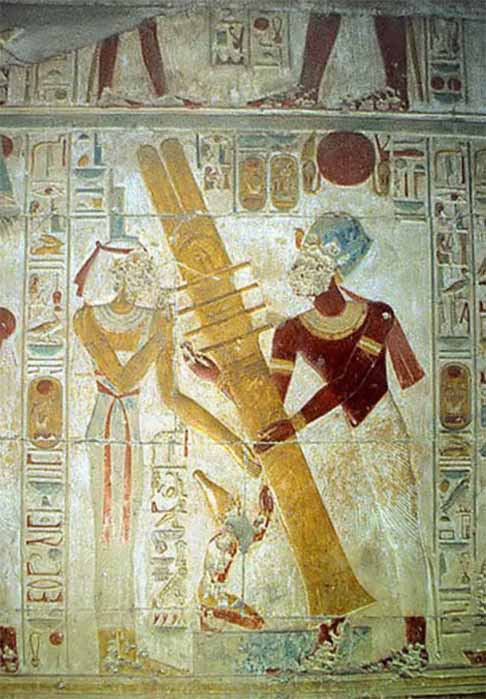
This Djed pillar was the sacred link that unites man to the divine world. Raising the Djed pillar, Temple of Seti I, Abydos, Egypt ( Public Domain)
Celestial Order of the Terrestrial World
As mentioned, the Korê Kosmou associates the original teachings of the primordial Hermes with the principle that the celestials order the terrestrial world in accordance with the design of the Creator. The institutions founded by Isis and Osiris operate in harmony with this design, restoring man to his proper place in the cosmic order. The role of the arts and sciences in this process is also discussed in the Asclepius, a Latin translation of a lost Greek Hermetic text. In the Asclepius, Hermes teaches that the dual constitution of man as an eternal soul encased in a material body fulfills the greater plan of the Creator, who “formed human beings of both spirit and body…of both eternal and mortal nature” so that they “could wonder at and adore the celestial, while they could also care for and manage the things on earth.” Hermes goes on to say that the arts and sciences—including arithmetic, music, and geometry—are only properly utilized in the context of celestial observations: “Pure philosophy, which depends only on reverence for God, should attend to these other subjects just sufficiently to marvel at the knowledge that the heavenly bodies return regularly to the same predetermined positions, and that the course of their orbits is obedient to number” (Asclepius 13)
As explained by Walter Scott, the Hermetists considered the heavenly bodies “the administrators by whose agency God governs the lower world…to recognize the regularity of their movements is to recognize the immutability of the divine laws by which all corporeal things are governed.” In learning from Hermes “how lower things were arranged by the Creator to correspond with things above” and establishing “the sacred procedures vertically aligned with the mysteries in heaven” (SH 23:68), Isis and Osiris raised a civilization embodying cosmic creation itself. As Hermes states in the Asclepius (24), “Egypt is the image of heaven…all things which are set in motion and regulated in heaven have been transferred, or have descended, into Egypt…our land is the temple of the whole cosmos.” Similarly, in another Stobaean Hermetic text, Isis tells Horus that Egypt is the very heart and soul of the cosmos (SH 24:13).
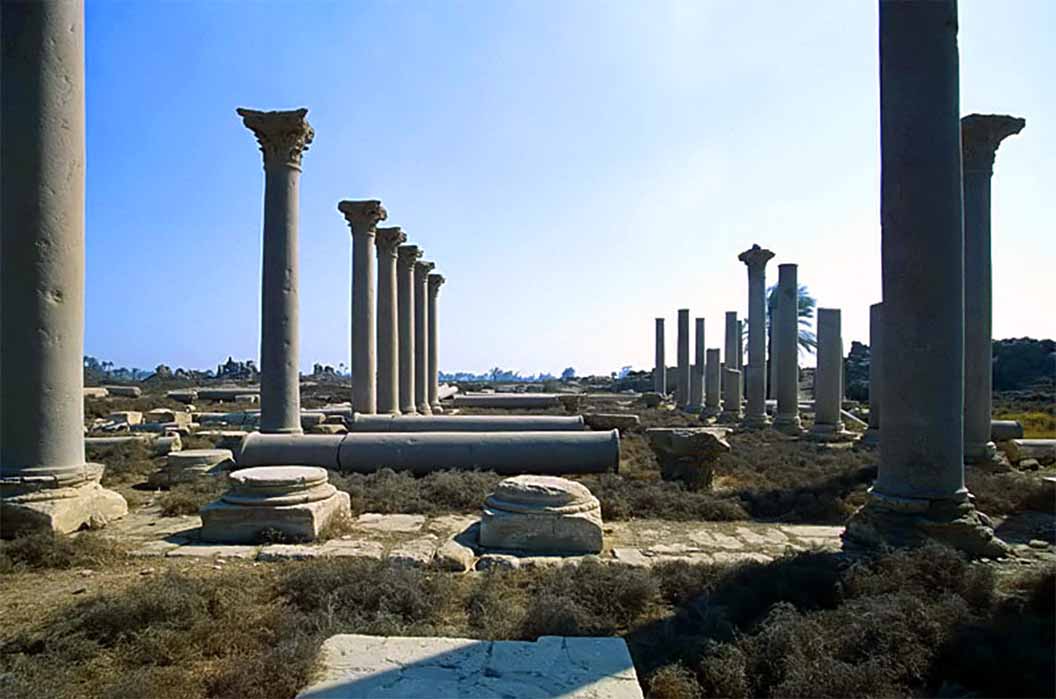
Fifth century Coptic Basilica of Hermopolis (Roland Unger/ CC BY-SA 3.0)
Egyptian Temple Ideology
These passages reflect the Egyptian temple ideology, in which the temple represents the cosmos, and embodies the axis mundi vertically connecting each region of creation. As such, the temple system was believed to perpetuate cosmic order and the rebirth of the world each day, and it was feared that the dissolution of temple practices would have catastrophic consequences for the entire universe. The Korê Kosmou extends this concept to envelope the entire sphere of human civilization, which must be aligned with and reflect the cosmic order to counteract the chaos that was before. As mentioned, this also includes such “mundane” practices as the cultivation of food sources. In the Asclepius Hermes teaches that man must employ the arts and sciences in accordance with the cosmic design in all the practical activities of civilization: “I do not only mean earth and water, two of the four elements which nature has made subject to human beings, but also those things which humans are responsible for doing in, or with, these elements: the cultivation of the earth itself, pasturage, building, ports, navigation, communication, trade. All these constitute the strongest bond between human beings, and between them and that part of the world which is composed of water and earth. This earthly part of the world is maintained by knowledge and practice of the arts and sciences, without which God has willed that it would not be brought to perfection.”
Culture and civilization are figured into the sacred role of mankind, yet it is only when these endeavors are aligned with the divine plan of the Creator reflected in the movements of the heavenlies that they fulfill their true purpose of beautifying the world. True civilization fulfills the dual purpose of man to wonder at the celestials while caring for the things of earth, establishing a harmonious interface of the heavenly with the terrestrial and the eternal with the temporal. The civilization founded by Isis and Osiris through the teachings of Hermes was an incursion of divine order in the world that banished the preceding state of chaos.
Prophesy of the End of Egyptian Civilization
The temple that was Egyptian civilization had to be maintained in order to sustain the cosmic order. There was a sense that if tradition were forgotten and the temples abandoned, order would give way and chaos would again envelop mankind and the whole world. Sometime in the early third century AD, a Hermetic scribe wrote a prophecy predicting the end of Egyptian civilization and, ultimately, the world. The prophecy was incorporated into the teachings of Hermes in the Greek Perfect Discourse, which survives in both Latin (Asclepius 24-26) and Coptic (Nag Hammadi Codex 6.70-74) translations. The prophecy foretells a time when “Egyptians will seem to have served the divinity in vain, and all their activity in their religion will be despised. For all divinity will leave Egypt, and will flee upward to heaven” (NHC 6.70). The withdrawal of the divine is triggered when foreign occupiers enact “a prohibition under penalty prescribed by law…against reverence, fidelity and divine worship” (Ascl. 24). The traditions of old will be remembered only from fables and words etched in stone monuments, and the Egyptian will be treated as a foreigner in his own land (Ascl. 24).
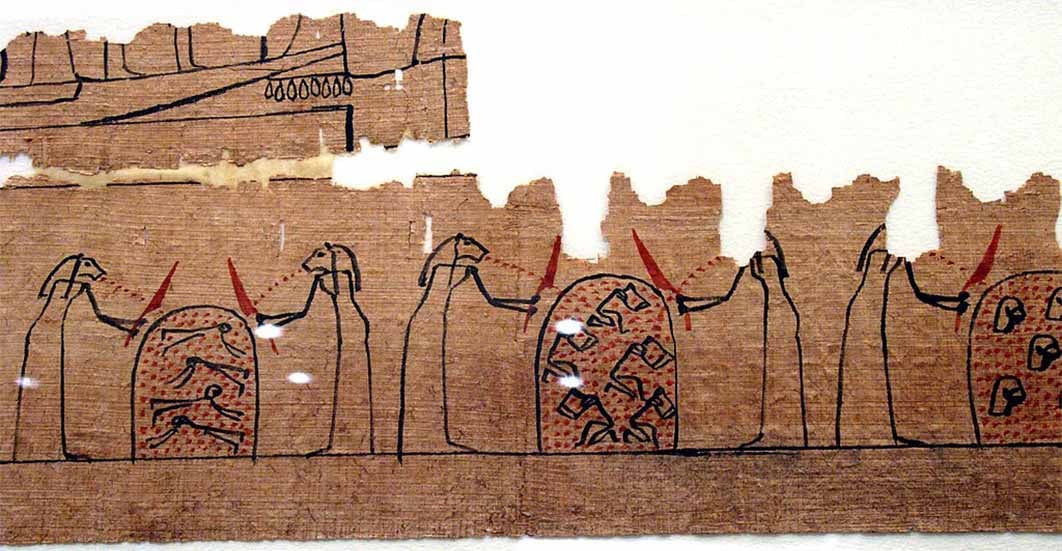
Scenes of otherworldly punishment from a papyrus of Amduat (21st Dynasty). Metropolitan Museum of Art. (CCO)
With his connection to the eternal lost, man will come to fear and despise the cosmos and nature itself, as all ethics and moral standards are inverted: "They will prefer shadows to light, and they will find death more expedient than life. No one will look up to heaven. The reverent will be thought mad, the irreverent wise; the lunatic will be thought brave, and the scoundrel will be taken for a decent person” (Ascl. 25). The immortal soul of man will be considered a ridiculous illusion, leading to the outlawing of transcendental philosophy: “Whoever dedicates himself to reverence of mind will find himself facing a capital penalty" (Ascl. 25). The loss of the ancient traditions has catastrophic results for human life. Egypt “will be filled completely with tombs and corpses” (Ascl. 24), and the Nile River “will flow with blood more than water. And dead bodies will be (stacked) higher than the dams” (NHC 6.71). With the connection to the divine severed by the oppressive laws of tyrants, fallen angels take up habitation in the temples and provoke man to overturn the natural order: “The wicked angels will remain among men, (and) be with them, (and) lead them into wicked things recklessly, as well as into atheism, wars, and plunderings, by teaching them things contrary to nature. In those days, the earth will not be stable, and men will not sail the sea, nor will they know the stars in heaven. Every sacred voice of the word of God will be silenced, and the air will be diseased. Such is the old age of the world: atheism, dishonor, and the disregard of noble words” (NHC 6.73).
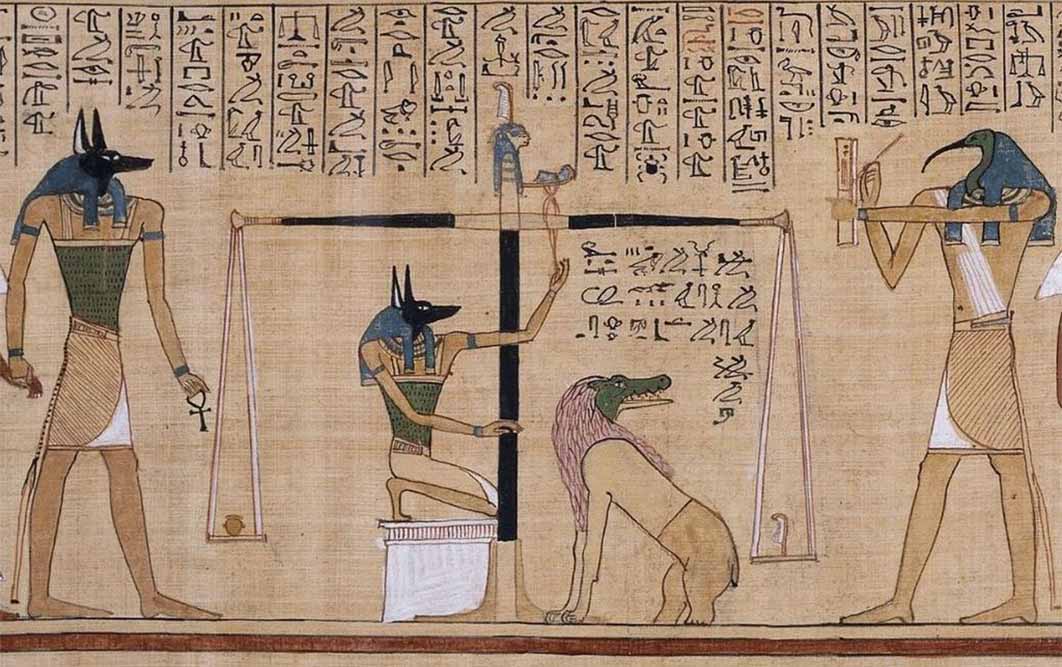
Detail from the Papyrus of Hunefer (c. 1275 BC) depicts the jackal-headed Anubis weighing a heart against the feather of truth on the scale of Maat, while ibis-headed Thoth records the result. Having a heart equal to the weight of the feather allows passage to the afterlife, whereas an imbalance results in a meal for Ammit, the chimera of crocodile, lion, and hippopotamus (Public Domain)
The world thus reverts back to the chaos state prior to the establishment of true civilization as described in the Korê Kosmou: ignorance again reigns supreme, the wicked are revered, and the people are slaughtered through exploitation and organized warfare. Perhaps because man has come to hate the cosmos, he is seduced by the evil angels into overturning nature itself. The prophecy in the Perfect Discourse concludes with an allusion to the completion of the Platonic Great Year, except here the Supreme God intervenes to restore creation: “He will take a stand against these evils and against the universal corruption. He will restrain error and every malign influence. Either he will dissolve all this in a flood, or consume it by fire, or destroy it through disease and pestilence spread through different lands. Finally he will restore the world to its ancient beauty, so that it may again appear worthy of reverence and wonder, and also that God the creator and restorer of so great a work may be worshipped by people then living with continual hymns of praise and benediction. By these events the world will be reborn” (Ascl. 26).
Civilization and Chaos
It is interesting to compare the contrasting states of civilization and chaos as described in these Hermetic texts. Civilization is an alignment of human activity with the design and process of creation itself. This state is characterized by just laws which protect the weak from exploitation by the powerful and sanctify human life, systems of equitable food sustenance and distribution, and the freedom to worship and philosophize. Chaos on the other hand comes about by the loss of homeostasis with the cosmos, and is characterized by the exploitation, oppression, and slaughter of the weak by the powerful, perpetual and organized warfare, and the outlawing of certain forms of worship, thought, and expression. The powerful who benefit from this latter sordid state of affairs grow to hate nature itself and ally with fallen angels to overturn the natural order of the cosmos.
Echoing across nearly two millennia, these texts constitute a challenge to ponder the state of civilization in the modern world. Has modern man discovered a place of meaning for humanity in the universe or merely invented more and more sophisticated ways of enslaving people and subjugating nature? Do current temples offer divine guidance or have they too become the tools of wicked powers? Does that which is above align with that which is below, or do the elements cry out again?
Jason Jarrell is co-author of Ages of the Giants: A Cultural History of the Tall Ones in Prehistoric America, available from LuLu.com. His website is https://www.paradigmcollision.com/
Top Image: Isis with Osiris in the background ( OLGA RA/ Adobe Stock)
By: Jason Jarrell
References
Brashler, J. Dirkse, P.A., and Parrott, D.M. 1990a. Asclepius 21-29. The Nag Hammadi Library in English, ed. James M. Robinson. Brill
Copenhaver, B. P. 1992. Hermetica: The Greek Corpus Hermeticum and the Latin Asclepius in a New English Translation, with Notes and Introduction. Cambridge University Press.
Litwa, D. M. 2018. Hermetica II: The Excerpts of Stobaeus, Papyrus Fragments, and Ancient Testimonies in and English Translation with Notes and Introductions. Cambridge University Press.
Salaman, C. 2007. Asclepius: The Perfect Discourse of Hermes Trismegistus. Bloomsbury Publishing.
Scott, W.1926. Hermetica: The Ancient Greek and Latin Writings which Contain Religious or Philosophic Teachings Ascribed to Hermes Trismegistus, Vol. 3: Notes on the Latin Asclepius and the Hermetic Excerpts of Stobaeus, Oxford, Clarendon Press.




